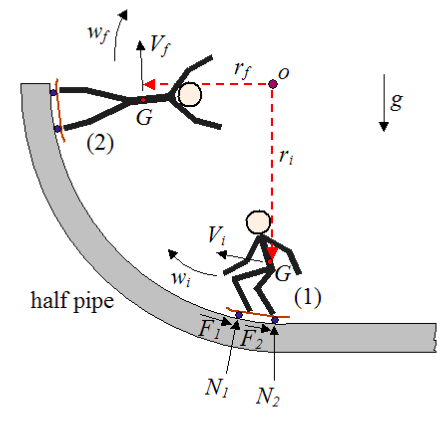Skateboarding is physics! Find out what principles of physics a skateboarder uses to appear to defy gravity on the half-pipe.
By Kate Stone and Dr. Jonathan Trinastic
People skateboarding might seem to defy gravity as they soar high above a half-pipe, but they are actually taking advantage of specific physics principles that help them reach such heights. Physicist Dr. Jonathan Trinastic explains.
Kate: As a physicist, what do you see happening in these photos?

Jonathan: People skateboarding on a half-pipe take advantage of two primary physics conservation principles: conservation of energy and angular momentum. Let’s start with conservation of energy. Energy can be broken down into two main categories: kinetic energy and potential energy. Kinetic energy is associated with movement and is proportional to the square of the velocity of an object—in this case the skateboarder. Potential energy is different depending on what force the skateboarder is feeling, but in this case that force is gravity. With gravity, the potential energy is proportional to how high from ground level the skateboarder is: the higher the skateboarder, the more potential energy she has. The key idea behind conservation of energy is that the total amount of kinetic plus potential energy can never change, but each can be transformed into the other.
Kate: So, how do these principles apply to the half-pipe?

Jonathan: Usually, a person skateboarding will start from a high platform near the top of the half-pipe. This gives her a large amount of potential energy since she is high up, but no kinetic energy since she starts at rest. This also means her total amount of energy is equal to her potential energy. Now, the skateboarder jumps down on her board and begins rolling down the half-pipe. She loses potential energy but picks up speed—this indicates that her potential energy has converted to kinetic energy. When she reaches the bottom of the half-pipe, she has lost all her potential energy but has a lot of kinetic energy in the form of a high speed. The skateboarder can then use this speed to zoom up the other side of the half-pipe and launch into the air to do tricks.
Kate: In that case, how do skateboarders get so high on their jump, seemingly higher than their starting points on the other side of the half-pipe?

Jonathan: The answer lies in the second physics principle: conservation of angular momentum. Just like traditional momentum being equal to mass times velocity, angular momentum is a rotational analogue, equal to an object’s moment of inertia times its angular velocity. Moment of inertia can be thought of as a “rotational mass” and depends on the mass of an object and its distance from its axis of rotation. The farther an object is from its axis of rotation, the larger its moment of inertia, and therefore the larger its angular momentum. Angular momentum must always be conserved, so if the object’s angular velocity increases, then its moment of inertia must decrease, or vice versa.
Kate: What does this have to do with the skater on the half-pipe?
Jonathan: A skater can take advantage of angular momentum conservation to get especially high on her half-pipe jump. First, consider her axis of rotation as she’s curving up the half-pipe. If we consider the half-pipe as one-quarter of a circle, then the skateboarder is rotating in a circular motion as she moves along the half-pipe, with an axis of rotation somewhere in space far from the half-pipe itself. Now, remember that the moment of inertia increases with distance from the axis of rotation. Therefore, if the skateboarder crouches during her approach to the half-pipe, her center of mass moves farther away from the axis of rotation, increasing her moment of inertia. Now, just as she’s flying up the half-pipe, she extends her body straight as far as she can and shoots her hands in the air. This moves her center of mass up and closer to the axis of rotation, decreasing her moment of inertia. Since angular momentum must be conserved, her angular velocity must increase, giving her even more speed as she hits the top of the half-pipe and flies into the air, doing as many tricks as she can. Thus, she has used the principles of momentum conservation to get extra “air” above the half-pipe.
RELATED: Waves of Physics: The Science of Surfing
Kate: That was a lot of good information. How can understanding physics help a skater successfully execute a half-pipe?
Jonathan: The short answer is that skateboarders can change their speed coming off the half-pipe by first crouching and then shooting straight up.
Kate: What is centrifugal force and how can someone use it skate up a wall?
Jonathan: Centrifugal force is actually a “fictitious force,” in that it’s actually not a physical force such as gravity or electromagnetism that is affecting you. Instead, the centrifugal force arises when considering dynamics from a rotating reference frame. All motion must be considered from some reference frame. If you are standing at your window watching a rabbit run across your lawn, then your frame of reference measuring the rabbit motion would be stationary—you at the window. The rabbit motion would look different if you were running away from it, for example, which would be a moving reference frame.
In the same way, as a skateboarder moves in a circular motion up the half-pipe, she is now in an accelerating reference frame, with a centripetal (not centrifugal) force pulling her toward her axis of rotation. A stationary observer would observe this force acting on the skateboarder. However, from the

skateboarder’s frame of reference, she feels a fictitious centrifugal force pulling her against the half-pipe wall, due to her inertia taking her in a direction tangential to her circular motion.
This centrifugal fictitious force is felt by anyone moving in circular motion. A common example is on spinning amusement park rides, which plaster us against the walls with nothing supporting us below. Although it feels like a force is pushing us into the wall, it’s really just the inertial motion from the circular path we take.
Kate: Are skateboarders defying gravity? Also, what is gravity?
Jonathan: Gravity is the force between any two objects with mass. Normally, we think of gravity between us and the Earth, but we actually have a gravitational attraction between us and any other thing around us: a tree, a water glass, a friend.

That gravitational force is just so weak that we don’t notice it. The only reason we feel the gravitational attraction to the Earth is because the planet is so massive!
It can seem like skateboarders defy gravity, but the force is always acting on them. Skateboarders can just take advantage of other physics principles—principles of energy conservation and angular momentum to help fly through the air and seemingly defy gravity. But gravity is always acting on them and is the only reason that skateboarders come back to earth after a good jump. So no, skateboarding doesn’t actually defy gravity.
Kate: What other physics principles do we see in skateboarding?
Jonathan: In addition to potential and kinetic energy, some energy is lost due to friction between the wheels and the ground during a skateboarder’s run. For this reason, she can’t go up and down the half-pipe forever skateboarding; over time, she will lose energy to friction, so she can’t maintain the same amount of kinetic energy, which in turn can’t be converted to the same amount of potential energy to reach such high heights on her jumps.
Photography of Lisa Fahncke, Justin Philip Nash, and others skateboarding by Kate Stone, SOMA Skatepark in San Francisco, May 2017.




